+ データを開く
データを開く
- 基本情報
基本情報
| 登録情報 | データベース: PDB / ID: 8ga1 | ||||||
|---|---|---|---|---|---|---|---|
| タイトル | CLC-ec1 R230C/L249C/C85A at pH 4.5 100mM Cl Swap | ||||||
 要素 要素 | H(+)/Cl(-) exchange transporter ClcA | ||||||
 キーワード キーワード | TRANSPORT PROTEIN / CLC-ec1 / ecCLC / eriC / CLC transporter / chloride proton antiporter | ||||||
| 機能・相同性 | Chloride channel, ClcA / Chloride channel, voltage gated / Chloride channel, core / Voltage gated chloride channel / voltage-gated chloride channel activity / antiporter activity / plasma membrane / H(+)/Cl(-) exchange transporter ClcA 機能・相同性情報 機能・相同性情報 | ||||||
| 生物種 |  | ||||||
| 手法 | 電子顕微鏡法 / 単粒子再構成法 / クライオ電子顕微鏡法 / 解像度: 2.6 Å | ||||||
 データ登録者 データ登録者 | Fortea, E. / Lee, S. / Argyos, Y. / Chadda, R. / Ciftci, D. / Huysmans, G. / Robertson, J.L. / Boudker, O. / Accardi, A. | ||||||
| 資金援助 |  米国, 1件 米国, 1件
| ||||||
 引用 引用 |  ジャーナル: Nat Struct Mol Biol / 年: 2024 ジャーナル: Nat Struct Mol Biol / 年: 2024タイトル: Structural basis of pH-dependent activation in a CLC transporter. 著者: Eva Fortea / Sangyun Lee / Rahul Chadda / Yiorgos Argyros / Priyanka Sandal / Robyn Mahoney-Kruszka / Hatice Didar Ciftci / Maria E Falzone / Gerard Huysmans / Janice L Robertson / Olga ...著者: Eva Fortea / Sangyun Lee / Rahul Chadda / Yiorgos Argyros / Priyanka Sandal / Robyn Mahoney-Kruszka / Hatice Didar Ciftci / Maria E Falzone / Gerard Huysmans / Janice L Robertson / Olga Boudker / Alessio Accardi /   要旨: CLCs are dimeric chloride channels and anion/proton exchangers that regulate processes such as muscle contraction and endo-lysosome acidification. Common gating controls their activity; its closure ...CLCs are dimeric chloride channels and anion/proton exchangers that regulate processes such as muscle contraction and endo-lysosome acidification. Common gating controls their activity; its closure simultaneously silences both protomers, and its opening allows them to independently transport ions. Mutations affecting common gating in human CLCs cause dominant genetic disorders. The structural rearrangements underlying common gating are unknown. Here, using single-particle cryo-electron microscopy, we show that the prototypical Escherichia coli CLC-ec1 undergoes large-scale rearrangements in activating conditions. The slow, pH-dependent remodeling of the dimer interface leads to the concerted opening of the intracellular H pathways and is required for transport. The more frequent formation of short water wires in the open H pathway enables Cl pore openings. Mutations at disease-causing sites favor CLC-ec1 activation and accelerate common gate opening in the human CLC-7 exchanger. We suggest that the pH activation mechanism of CLC-ec1 is related to the common gating of CLC-7. | ||||||
| 履歴 |
|
- 構造の表示
構造の表示
| 構造ビューア | 分子:  Molmil Molmil Jmol/JSmol Jmol/JSmol |
|---|
- ダウンロードとリンク
ダウンロードとリンク
- ダウンロード
ダウンロード
| PDBx/mmCIF形式 |  8ga1.cif.gz 8ga1.cif.gz | 159.1 KB | 表示 |  PDBx/mmCIF形式 PDBx/mmCIF形式 |
|---|---|---|---|---|
| PDB形式 |  pdb8ga1.ent.gz pdb8ga1.ent.gz | 123.5 KB | 表示 |  PDB形式 PDB形式 |
| PDBx/mmJSON形式 |  8ga1.json.gz 8ga1.json.gz | ツリー表示 |  PDBx/mmJSON形式 PDBx/mmJSON形式 | |
| その他 |  その他のダウンロード その他のダウンロード |
-検証レポート
| 文書・要旨 |  8ga1_validation.pdf.gz 8ga1_validation.pdf.gz | 991.3 KB | 表示 |  wwPDB検証レポート wwPDB検証レポート |
|---|---|---|---|---|
| 文書・詳細版 |  8ga1_full_validation.pdf.gz 8ga1_full_validation.pdf.gz | 994.7 KB | 表示 | |
| XML形式データ |  8ga1_validation.xml.gz 8ga1_validation.xml.gz | 34.1 KB | 表示 | |
| CIF形式データ |  8ga1_validation.cif.gz 8ga1_validation.cif.gz | 49.8 KB | 表示 | |
| アーカイブディレクトリ |  https://data.pdbj.org/pub/pdb/validation_reports/ga/8ga1 https://data.pdbj.org/pub/pdb/validation_reports/ga/8ga1 ftp://data.pdbj.org/pub/pdb/validation_reports/ga/8ga1 ftp://data.pdbj.org/pub/pdb/validation_reports/ga/8ga1 | HTTPS FTP |
-関連構造データ
| 関連構造データ |  29884MC 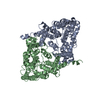 8ga0C 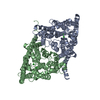 8ga3C 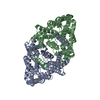 8ga5C 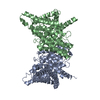 8gahC M: このデータのモデリングに利用したマップデータ C: 同じ文献を引用 ( |
|---|---|
| 類似構造データ | 類似検索 - 機能・相同性  F&H 検索 F&H 検索 |
- リンク
リンク
- 集合体
集合体
| 登録構造単位 | 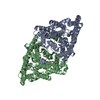
|
|---|---|
| 1 |
|
- 要素
要素
| #1: タンパク質 | 分子量: 49118.027 Da / 分子数: 2 / 変異: C85A,R230C,L249C / 由来タイプ: 組換発現 / 由来: (組換発現)   #2: 化合物 | ChemComp-CL / #3: 水 | ChemComp-HOH / | 研究の焦点であるリガンドがあるか | Y | Has protein modification | Y | |
|---|
-実験情報
-実験
| 実験 | 手法: 電子顕微鏡法 |
|---|---|
| EM実験 | 試料の集合状態: PARTICLE / 3次元再構成法: 単粒子再構成法 |
- 試料調製
試料調製
| 構成要素 | 名称: Structure of ecCLC-R230C/L249C/C85A mutant at pH 4.5 in 100mM Cl タイプ: CELL / Entity ID: #1 / 由来: NATURAL |
|---|---|
| 由来(天然) | 生物種:  |
| 緩衝液 | pH: 4.5 |
| 試料 | 包埋: NO / シャドウイング: NO / 染色: NO / 凍結: YES |
| 急速凍結 | 凍結剤: ETHANE |
- 電子顕微鏡撮影
電子顕微鏡撮影
| 実験機器 |  モデル: Titan Krios / 画像提供: FEI Company |
|---|---|
| 顕微鏡 | モデル: FEI TITAN KRIOS |
| 電子銃 | 電子線源:  FIELD EMISSION GUN / 加速電圧: 300 kV / 照射モード: FLOOD BEAM FIELD EMISSION GUN / 加速電圧: 300 kV / 照射モード: FLOOD BEAM |
| 電子レンズ | モード: BRIGHT FIELD / 最大 デフォーカス(公称値): 2000 nm / 最小 デフォーカス(公称値): 700 nm |
| 撮影 | 電子線照射量: 56.11 e/Å2 / フィルム・検出器のモデル: GATAN K3 (6k x 4k) |
- 解析
解析
| ソフトウェア |
| ||||||||||||||||||||||||
|---|---|---|---|---|---|---|---|---|---|---|---|---|---|---|---|---|---|---|---|---|---|---|---|---|---|
| EMソフトウェア | 名称: cryoSPARC / バージョン: 3.3.2 / カテゴリ: 粒子像選択 | ||||||||||||||||||||||||
| CTF補正 | タイプ: PHASE FLIPPING AND AMPLITUDE CORRECTION | ||||||||||||||||||||||||
| 3次元再構成 | 解像度: 2.6 Å / 解像度の算出法: FSC 0.143 CUT-OFF / 粒子像の数: 718295 / 対称性のタイプ: POINT | ||||||||||||||||||||||||
| 精密化 | 立体化学のターゲット値: CDL v1.2 | ||||||||||||||||||||||||
| 拘束条件 |
|
 ムービー
ムービー コントローラー
コントローラー







 PDBj
PDBj


